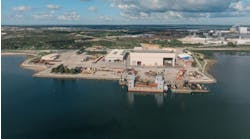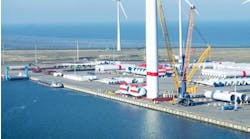David Paganie,Houston
The oiland gas supply chain is positioning for what appears to be an emerging US offshore wind market. There are at least 12 projects in various stages of development in the US that could deliver about 10 GW of power by 2030.
The first US offshore wind farm, Deepwater Wind’s five-turbine, 30-MW Block Island offshore Rhode Island, has been operating since 2016, and paves the way for likeminded developers. Plans have been filed with BOEM for the construction and operations of two projects. One of them, South Fork Wind, calls for 15 turbines offshore Rhode Island that would connect to a grid in East Hampton, New York. Meanwhile, BOEM is planning to auction leases offshore Massachusetts on Dec. 18 of this year, and possibly acreage offshore New York in 2019. The results of the auction for acreage in Massachusetts state waters, where the wind resources and local market demand are considered ideal for project development, will be a strong indicator of developer confidence in the market. Nineteen companies have prequalified for the lease sale. Federal regulators are also gauging interest in areas offshore California, for a possible future lease sale.
Oil and gas contractors, service companies, and suppliers have been investigating opportunities in wind to help fill backlogs while awaiting activity in their core market to pick up. There are many skills and services that are transferrable between offshore oil and gas and offshore wind. For wind, these include project management; site surveys; supply and installation of wind farm foundations, substations, and cables; and operations and maintenance. Deepwater Wind employed a combination of skills and services from both East Coast and Gulf Coast companies to deliver Block Island. A study by the Renewables Consulting Group (RCG) forecasts more than $50 billion in capital requirements by 2030, led by projects offshore Rhode Island, Massachusetts, New York, and New Jersey (the results of this study were presented by Stephanie McClellan, director, Special Initiative on Offshore Wind, University of Delaware, at PennWell’s Offshore Wind Executive Summit in September in Houston). The bulk of the contracts will be for turbine supply and installation, followed by foundation supply and installation, and offshore substation and cable supply and installation. Developers will continue to employ service providers from oil and gas until the supply chain is more developed near the market.
The offshore wind industry also will continue to seek knowledge transfer and lessons learned from Europe where the market is already established. Denmark-based Ørsted, through its recent acquisition of Deepwater Wind, intends to take a leading role in developing the US wind market, with its background in engineering, construction, and operations of large-scale projects in Europe.
The US states in the northeast are providing the impetus for renewable development. For example, Massachusetts is targeting 40% market share for renewables for its energy mix by 2030. State legislation requires 1,600 MW (800 MW already contracted) from offshore wind to reach the goal. New York requires 50% of its energy from renewables by 2030, and a goal of 2,400 MW from offshore wind. New Jersey is also seeking 50% from renewables by 2030, but a higher target – 3,500 MW – from offshore wind. On the West Coast, California is targeting an aggressive 100% renewable energy by 2045. But there are more hurdles to clear off the West Coast compared to the East Coast, including water depths in California state waters that would require floating wind installations. The first floating wind farm - Equinor-operated Hywind offshore Scotland - started production in October 2017. It uses spar-based technology from oil and gas. Wind developers will seek more floating installations (and guidance from oil and gas) as the industry matures and moves farther out from shore and into deeper waters.
The states that have been lobbying for renewable development see it as an opportunity for local job growth and other economic benefits. Some of the states will give preference to developer bids that indicate a plan for local content development. New York state regulators have said they will select proposals based on price (70%), local content (20%), and efficiency (10%).
Indeed, navigating individual state requirements and eventually federal mandates is a top priority for developers, but it is just one of the many obstacles that need to be addressed for market growth. Other offshore challenges include improving the permitting process, working with commercial and recreational fishing, viewshed, navigation and safety, environment impact, complying with the Jones Act for turbine installation, and bringing down costs to compete with onshore wind and solar.
Despite the challenges, there appears to be enough demand for renewables and legislative support for US offshore wind to develop into a lucrative market. Globally, offshore wind is excepted to grow from 17.6 GW in 2017 to 114.9 GW in 2030 (16% CAGR), led by Europe and Asia, according to Bloomberg NEF. The energy transition is under way, and oil and gas operators and service companies will continue to leverage their experience from offshore to develop renewable resources.


